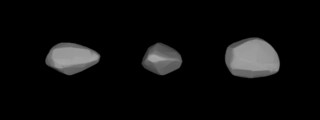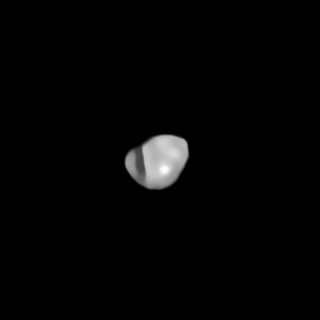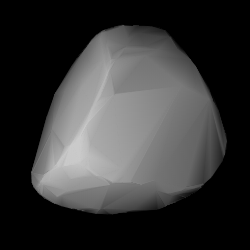Related Research Articles

Aethra is a metallic asteroid and Mars-crosser on an eccentric orbit from the asteroid belt. It measures approximately 40 kilometers in diameter.

Lamberta is a main-belt asteroid that was discovered by Corsican-born French astronomer Jérôme Eugène Coggia on April 11, 1878, and named after the astronomer Johann Heinrich Lambert. It was the second of Coggia's five asteroid discoveries.

Isabella is a large and dark asteroid from the central asteroid belt, approximately 80 kilometers in diameter. It was discovered in Pola by Johann Palisa on 12 November 1879. The origin of the name is unknown. The asteroid is probably composed of material similar to carbonaceous chondrites. It is classified as a member of the Nemesis family of asteroids.

Germania is a very large main-belt asteroid. It is classified as a B-type asteroid and is probably composed of dark, primitive carbonaceous material.

Vaticana is a large Main belt asteroid.
Edna is a large Main belt asteroid.
Bruchsalia is a main-belt asteroid. It was discovered by Max Wolf and Friedrich Karl Arnold Schwassmann on May 22, 1900. Its provisional name was 1900 FG.
Emita is a minor planet orbiting the Sun that was discovered by the Italian astronomer Luigi Carnera on February 12, 1902. The meaning of the asteroid's proper name remains unknown.
Carina is a minor planet orbiting the Sun.
Evelyn is a main belt asteroid discovered by Raymond Smith Dugan on 19 January 1903. The asteroid was named after Evelyn Smith Dugan, mother of the discoverer.
Marianna is a minor planet orbiting the Sun.
Tekmessa is a minor planet orbiting the Sun that was discovered by American astronomer Joel Hastings Metcalf on February 16, 1906. The name may have been inspired by the asteroid's provisional designation 1906 TK.

626 Notburga is a large, dark asteroid orbiting the Sun in the asteroid belt.
676 Melitta is a minor planet orbiting the Sun. It is classified as a main belt asteroid. The name, Melitta, is the Attic Greek form of the name Melissa—a reference both to the nymph of ancient Greek mythology, and to the minor planet's discoverer, Melotte.

681 Gorgo is a minor planet orbiting the Sun.

690 Wratislavia is a minor planet orbiting the Sun. Wratislavia was discovered on October 16, 1909. IRAS data shows it is about 135 km in diameter.
712 Boliviana is a C-type asteroid from the asteroid belt, with the type indicating the surface has a low albedo with high carbonaceous content. The spectra of the asteroid displays evidence of aqueous alteration. It is named after Simón Bolívar.
769 Tatjana is a minor planet orbiting the Sun. The body was named such after Tatiana Larina, protagonist of Alexander Pushkin's poem "Eugene Onegin". It's possible that the name was suggested by the provisional designation of the asteroid, 1913 TA, but unlike bodies named by Wolf, Knopff and Metcalf in the years 1905–1909, there's no naming pattern to support this.
854 Frostia is a main-belt asteroid orbiting the Sun. It was discovered in 1916 by Sergei Ivanovich Belyavsky from Simeiz Observatory in Crimea and is named after Edwin Brant Frost, an American astronomer. This asteroid measures approximately 8.4 km (5.2 mi) in diameter.
116903 Jeromeapt – provisional designation 2004 GW – is an asteroid of the Massalia family from the inner regions of the asteroid belt, approximately 1.1 kilometers in diameter. It was discovered on 11 April 2004, by American astronomer Jim Young at the Table Mountain Observatory near Wrightwood, California, in the United States. The asteroid was named for American astronaut Jerome Apt.
References
- 1 2 "680 Genoveva (1909 GW)". JPL Small-Body Database . NASA/Jet Propulsion Laboratory . Retrieved 7 May 2016.
- 1 2 3 Carry, B. (December 2012), "Density of asteroids", Planetary and Space Science, vol. 73, pp. 98–118, arXiv: 1203.4336 , Bibcode:2012P&SS...73...98C, doi:10.1016/j.pss.2012.03.009. See Table 1.